#Los Angeles County Natural History Museum
Text
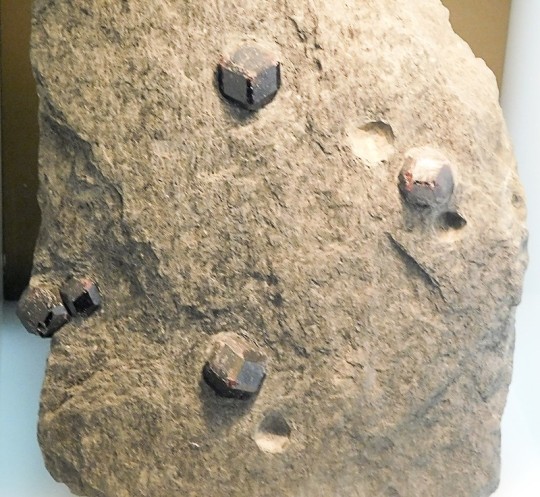
Almadine in Schist
#geology#Almadine#Schist#minerals#crystals#museum of natural history#Exposition Park#los angeles#los angeles county#california#photo#digital#original photographers
38 notes
·
View notes
Text
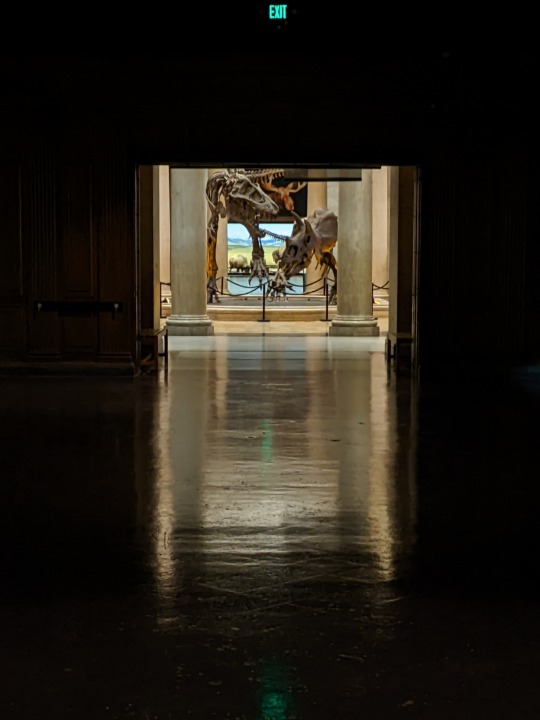
Dino Fight at the Exit, Natural History Museum of Los Angeles, October 2023
#dinosaurs#museums#natural history museum of los angeles#los angeles county museum#los angeles#california#dinosaurs are cool#original photography#photographers on tumblr#google pixel 3a#bruce sharp#2023#triceratops
8 notes
·
View notes
Photo

HUNDREDS OF NEW CREEPY CRAWLIES FOUND HIGH IN THE AMAZON
A yet-to-be-named phorid spy species 26 feet up
PHOTOGRAPH BY BRIAN BROWN, NATURAL HISTORY MUSEUM OF LOS ANGELES COUNTY
#brian brown#photographer#natural history museum of los angeles county#national geographic#phorid spy species#insect#amazon#nature
9 notes
·
View notes
Text
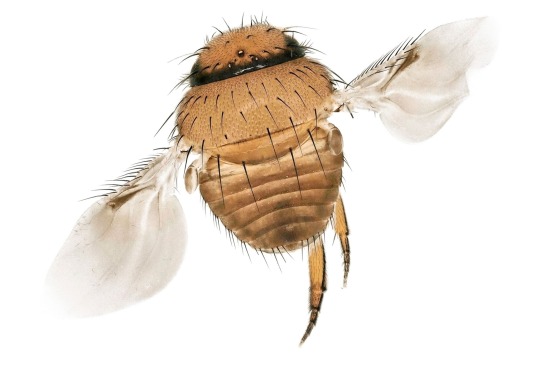
Trapped at eight meters (26 feet) above the ground, this yet-to-be-named phorid fly species is a “parasitoid death-dealing machine” that jabs its eggs into other insects, says entomologist Brian Brown. Brown, the curator of entomology at the Natural History Museum of Los Angeles County, photographed the insects in this article using a camera-and-microscope setup that was originally developed to examine flaws in computer chips. Photograph By Brian Brown, Natural History Museum of Los Aangele County
For Insects, The Amazon’s Canopy Contains A Dazzling Multiverse
A new study finds that high in rainforest trees, insects live in ecosystems that vary wildly from the forest floor on up.
— By Natasha Daly | Published March 2, 2022 | Saturday October 7, 2023
“I thought, my God, this is like someone’s discovered another continent!” says Brian Brown, an Entomology Curator at the Natural History Museum of Los Angeles County. He was talking about insects.
When studying insects in the Amazon, most entomologists cast their eyes down, to the intricate pathways of moss and underbrush that make up the rainforest floor. But José Albertino Rafael wanted to look up. Really far up—to more than 105 feet in the canopy.
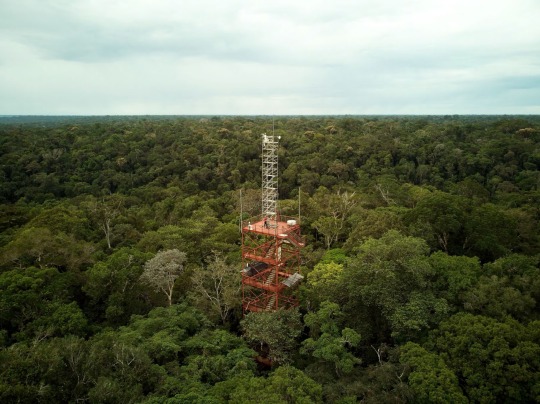
Two hours northwest of Manaus, Brazil, a 131-foot steel tower rises from a pristine area of the rainforest. Built in 1979, the tower had long been used to track the exchange of carbon dioxide between the trees and the atmosphere, but more recently it has been used for pioneering entomology research. Photograph By Craig Cutler
During two weeks in 2017, Rafael, an Entomologist at Brazil’s National Institute of Amazonian Research, and colleagues trapped insects at various heights, starting at ground level, from a 131-foot tower erected in the middle of the Amazon, just outside Manaus.
The findings were staggering, says Brown, who was part of a team that examined and recorded all 37,000 insects that were collected. Nearly half of them were flies. “There were weird and different things. I didn’t even know what genus these were, let alone species.”
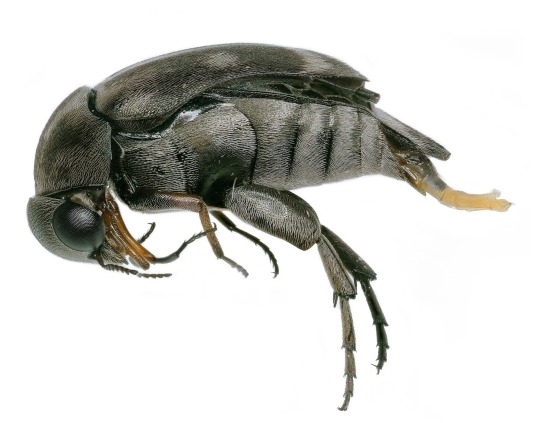
Ground Level: Tumbling flower beetles have a triangular body that helps them escape predators. Photograph By Brian Brown, Natural History Museum of Los Aangele County
The results of their analysis, published in Nature on February 2, point to a distinct and previously unexamined network of ecosystems in rainforest trees. More than 60 percent of the 857 species of flies collected, for example, were found above ground level. Many, if not most, likely are new species, Brown says.
Previous studies have compared insects on the ground with those in the canopy, but this is one of the first efforts to understand insect diversity at smaller vertical intervals.
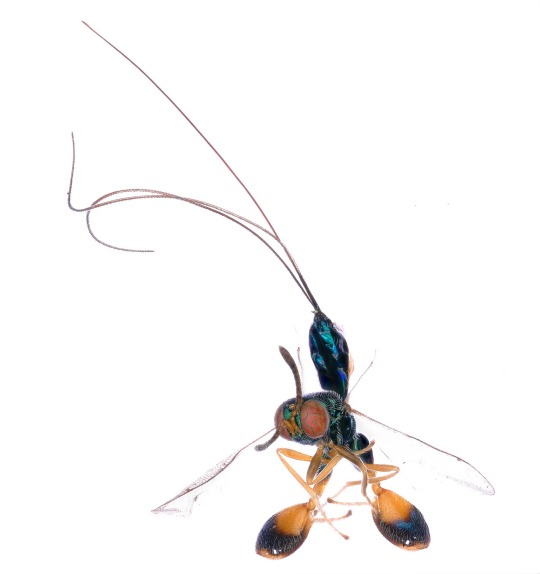
8 Meters (26 Feet): The mantis wasp uses its ovipositor—a needlelike organ for laying eggs—to pierce the egg cases of mantises. When the wasp’s larvae hatch, they feed on the mantis’s eggs. Photograph By Brian Brown, Natural History Museum of Los Aangele County
The findings underscore how much of the insect world still remains undiscovered, says Floyd Shockley, the collections manager of the entomology department at the Smithsonian Institution’s National Museum of Natural History, who was not involved in the study.
“Millions of things that live in the tropical canopy never come to ground,” he says, adding that these kinds of vertical studies “are incredibly important because [without them], we’re missing out on a tremendous amount of biodiversity.”
Sorting Insects
To collect the insects, Rafael set five large, tent-like netted traps off the tower at 26-foot intervals, starting at ground level and reaching up to 105 feet.
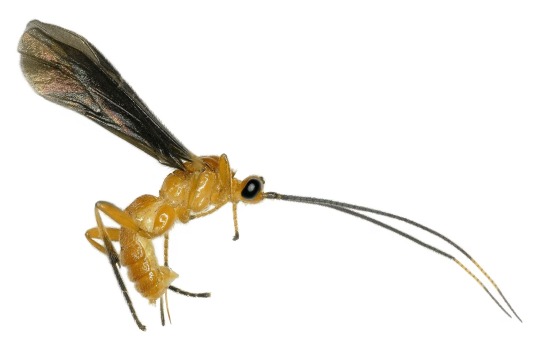
16 Meters (52 Feet): Both the forest canopy and the undergrowth are patrolled by parasitoid wasps seeking their prey—mostly caterpillars. Photograph By Brian Brown, Natural History Museum of Los Aangele County
Brown and Dalton de Souza Amorim, an entomologist at the University of Sao Paolo, and the rest of their team first sorted the insects by order (flies, beetles, bugs, and more). They focused on Diptera—flies—sorting more than 16,000 specimens into 56 families, then into 857 species. It’s unclear how many of those species are new to science. “It would take years and a ton of research to find out,” Brown says, but he guesses that many or most are undescribed.
Some families of flies were most abundant and diverse on the ground. Others were concentrated in the canopy. Still others peaked at the middle levels. Notably, between 90 and 100 percent of specimens of some families of flies were found in the four highest traps.

24 Meters (79 Feet): The watchful jewel beetle's massive eyes allow it to flee from predators—and researchers—quickly, making the beetles difficult to collect for study. Photograph By Brian Brown, Natural History Museum of Los Aangele County
What’s the Bigger Picture?
So much remains unknown about insects. “We’re still finding fish and amphibians, but we’re getting pretty close on birds and mammals to having a complete picture on their diversity,” Shockley says. But scientific models estimate the number of undiscovered insect species at between five and 30 million. “Every time we get one of these studies, it helps us improve the model so we can see how much we haven’t discovered.”
There are many reasons why knowledge of so many insect species remains elusive. “They’re small, they’re fast, they’re highly diverse, and they can occupy almost any niche,” he says.
So “we have to understand how they interact with each other, us, and crops,” Shockley says. “And we can’t talk about what they’re doing until we put a name on what they are.”

32 Meters (105 Feet): Iridescent orchid bees, tropical cousins of bumblebees and honeybees, are among the multitude of insects that entomologists have collected at the observation tower. Photograph By Brian Brown, Natural History Museum of Los Aangele County
Most insect sampling has been done based on latitude and longitude and sometimes altitude—up a mountain, for example, where habitats can change dramatically. But by collecting insects vertically in forest habitats, which is hard to do, Shockley says, “we’re adding an additional dimension to our understanding of diversity in three-dimensional space.”
Flies get a bad rap—it can be hard for people to understand why we should care about them. “But organisms [like insects] are arguably way more important than mammals or birds for the structure of the forest,” Brown says. “They’re important for pollination, energy, recycling, and more. What would happen if there were no insects feeding on decaying bodies? The ecosystem services they provide are so vital—but almost invisible.”
#The Insects 🐞 🕷️ 🐜#The National Geographic#Natasha Daly#Brian Brown | Entomology Curator | Natural History Museum | Los Angeles County.#Manaus | Brazil 🇧🇷#Rafael | Entomologist | Brazil’s 🇧🇷 National Institute of Amazonian Research
0 notes
Text
The 10 Best Museums In Los Angeles | Most Fascinating Museums in L.A
The 10 Best Museums In Los Angeles | Most Fascinating Museums in L.A
Most Fascinating Museums in Los Angeles
Museums In Los Angeles: Museums are institutions that collect, preserve, and display objects and artifacts of historical, cultural, or scientific significance. They serve as centers of learning and education, offering visitors the opportunity to learn about different cultures, art, history, and science.
Museums can be found all over the world, and they…

View On WordPress
#best museums in los angeles#los angeles#los angeles attractions#los angeles california#los angeles county museum of art#los angeles museum#los angeles museums#los angeles natural history museum#los angeles things to do#los angeles travel#los angeles travel guide#museum#museums#museums in los angeles#natural history museum of los angeles county#things to do in los angeles#things to see in los angeles#what to do in los angeles
1 note
·
View note
Text
City Nature Challenge Results
City Nature Challenge Results

View On WordPress
#California Academy of Sciences#Canadian Wildlife Federation#City Nature Challenge#classrooms#CNCYXE#CPaws#CWF#EcoFriendly West#fungi#insects#lichen#mosaic#Natural History Museum Los Angeles County#Nature Conservatncy of Canada#NCC#PCAP#Prairie Conservation Action Plan#Saskatchewan#Saskatoon#SaskEnergy#SaskPower#SaskTel#SCHOOLS#Twihamwe
0 notes
Text

Maiasaura Herd Aerial View by Doug Henderson. 1983. From Terra: The Member's Magazine of The Natural History Museum of Los Angeles County. Volume 24, No. 3. January/February 1986.
Internet Archive
847 notes
·
View notes
Photo

Aztec Calendar Stone with Mr. Villaseñor applying the finishing touches. From "Los Angeles County Museum Quarterly 1965-66" by The Natural History Museum of Los Angeles County. https://www.instagram.com/p/ClHJHN9NybC/?igshid=NGJjMDIxMWI=
219 notes
·
View notes
Text

Happy Saturday, Clue Crew! I want to talk about the art displayed, next to Nancy Drew’s bed (as seen in Alibi in Ashes). I’ve already discussed (in a previous post) how Alphonse Mucha is featured, quite prominently, in several of the ND games. At a glance, one might think the three, framed posters, on the yellow wall, are his work. However, they were done by a contemporary of Mucha, named Paul Berthon. Like Mucha, Berthon worked in the Art Nouveau style, which is why it is easy confuse their pieces!
Paul Berthon…was a French artist who produced primarily posters and lithographs… Berthon studied as a painter in Villefranche-sur-Saône before moving to Paris… His study of the decorative arts influenced his print making, influencing the strong lines and natural details that guided his art. The vast majority of Berthon's lithographed posters did not include advertisements and were meant to stand on their own.

The piece on the far left, of Nancy’s wall, is a print named The Salon de Cent (Salon of the One Hundred). If you are unfamiliar what “the Salon” is, in reference to art history, it was:
…the official art exhibition of the French Academy of Fine Arts (Academie des Beaux-Arts) in Paris. First held in 1667, its name stems from its location at the Salon Carre in the Louvre. For almost 150 years…the Salon was the most prestigious annual or biannual art event in the world.
The aforementioned print, was advertising Salon des Cent, which was a commercial art exhibition in Paris, based at 31 Rue Bonaparte.
The Salon sold color posters, prints and reproductions of artwork to the general public at reasonable prices. The Salon held exhibitions until 1900. Many of the posters advertising Salon des Cent exhibitions have themselves become collectors’ items.

The middle poster of Nancy’s Art Nouveau collection, is another advertisement, for violin lessons (Leçons de Violin).

The last poster of the trio is L’Ermitage.
L’Ermitage was a monthly, literary review that was published in Paris, France between 1890 and 1907.
The publication came under new management in 1896 during which time the literary review was reorganized. Subjects included in the magazine expanded beyond poetry and plays to also include that of the visual arts. With the expansion of subjects, the editors decided to commission Art Nouveau illustrations to grace the covers…
Art Nouveau reflects the ideals and desires of Paris at the end of the nineteenth century, which include happiness and indulgence in life and beauty without all the turmoil and problems of the newly industrialized world. In this piece, Berthon uses a woman with long, flowing hair and flowers as a symbol of beauty and purity. The print consists of just four colors in addition to the black ink.
L’Ermitage was included in the Les Maitre de L’Affiches series, or Masters of the Poster. This series was originally offered as a subscription for collectors, in which a different poster was mailed out monthly and which could be bound together at the end of the year. L’Ermitage was mailed out in 1900 as plate 227 of the series. These posters were greatly appealing due to their smaller, more manageable size, and the high quality of printing materials. The original larger posters usually had to be rolled up to store and were printed with a lesser quality ink.
A lithograph copy of L’Ermitage is currently on display at the Los Angeles County Museum of Art in Los Angeles, California, the United States.
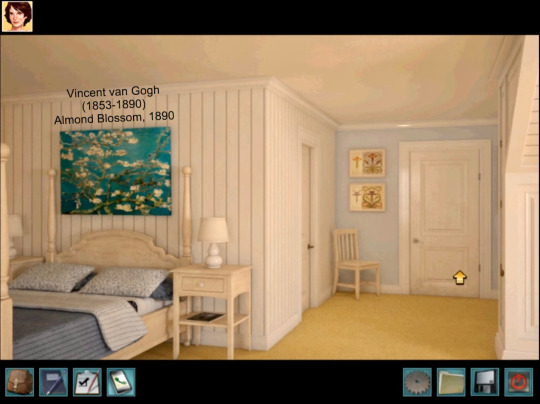
That does it, for the posters, on the yellow wall! But you’ll notice a canvas, prettily centered over Nancy’s bed. This is the very recognizable Almond Blossom, by the one and only, Vincent van Gogh.

You’ll see that the piece, in ASH, is a mirrored image, of van Gogh’s original. I can only assume this was done for copyright purposes, but that’s just conjecture.
Vincent loved nature. Blossoming trees, like in the painting Almond Blossom, were one of his favourite subjects to paint. He painted a number of variations on the theme: ranging from a small flowering sprig in a glass to lavishly blossoming trees.
Almond trees flower early in spring. The tree therefore marks the arrival of spring and the start of new life. And that was very appropriate in this case, as Vincent didn’t paint this work for just any old reason…
The painting was a gift for Vincent’s newborn nephew. The boy was born on 31 January 1890, and Theo and his wife Jo named him Vincent, after his uncle. Van Gogh was delighted to hear the news: ‘It does me, too, more good and gives me more pleasure than I could express in words’.
The painting became a treasured possession as soon as Vincent presented it to Theo and Jo as a gift. At first, it hung prominently above the piano in Theo and Jo’s living room. Later, once Jo had moved to Bussum following Theo’s death, the work hung in her and her son Vincent’s bedroom.
Following the death of Vincent and Theo, all of Vincent’s paintings passed into Jo’s hands. She sold a number of works during her lifetime, but Almond Blossom was so precious to Jo and her son that it was never to be sold. And that’s why to this very day, it is on display at the Van Gogh Museum.
For Van Gogh, painting Almond Blossom signified a new start. At the time, he had already been at an asylum in Saint-Rémy for almost ten months. Due to an attack of his illness, Vincent had not worked for weeks. He was now allowed back outside to paint, surrounded by nature.
Vincent worked hard, but that cost him dearly. Once he had completed the painting at the end of February, he had an attack that lasted for two months; his longest ever crisis. Once he had recovered, a new disappointment awaited: Vincent had missed his beloved flowering season.
‘If I’d been able to continue working, […] I would have done others of the trees in blossom. Now the trees in blossom are almost finished, […] I have no luck’.
Vincent chose an unusual perspective for Almond Blossom. He painted the branches from below and very close up. It is as if you are lying on your back on the grass, looking up at the branches above you, so that you can no longer see the entire tree. Vincent had seen this approach in Japanese printmaking and was inspired by it. These prints often zoom in on details from nature, and the image was sometimes cropped.
The subject itself also feels very Japanese, as blossom played a significant role in Japanese printmaking.
There you have it! I hope this information helps you appreciate ASH and Nancy’s room, a little more. I know I really appreciate the art, featured in the Nancy Drew games. I think it’s part of why I went into art history, to begin with! I owe a lot, to these games.
That is all. Happy scrolling.
#nancy drew#her interactive#clue crew#alibi in ashes#ash#vincent van gogh#paul berthon#nancy drew pc games#art nouveau
55 notes
·
View notes
Text
Very Personal Rage Against the Machine Song That Was Inspired by Zack De La Rocha's Father
A telling glimpse into Zack's life.

3

The lyrics in the song "Born of a Broken Man" are poetic and somewhat cryptic, which is a departure from the straightforward, in-your-face, sort of lyrical assault we are used to hearing from Rage Against The Machine. Naturally, this led many listeners to inquire what exactly this song is about.
The song was incredibly powerful, and it touched on a vulnerable part of Zack's life, as a result, the band didn't perform the song live as often as many fans wish they would. The band did play the song at a recent performance, after the song, Zack said the words, "Beto de la Rocha, I love you!", a shout-out to his father, Beto de la Rocha, who, I believe is still alive at age 84 and may very well have been in attendance at the concert.

We know that Beto was also very politically active. A 1995 Los Angeles Times article may shed some light on some of the lyrics in the song, "Born of A Broken Man". The article was meant to highlight his work after a massively successful LACMA exhibition by the Los Four, but according to the article, Beto decided to divorce his wife and move back in with his father. He put drapes on the windows and locks on the doors and only ventured out for groceries and to do the odd carpentry job to afford said groceries. There, he started reading the Bible all day, every day.
As Beto states in the LA Times article,
"Zack asked me if he could have a landscape drawing of mine. He was holding the drawing in front of me: 'Daddy, can I have that?' I said, 'Hey, that's mine,' Rocha recalls, pausing to fight back his tears. He grips his cane. 'Here was a very tender young boy asking for this thing--a piece of flat canvas with paint, an object, a nothing--and I denied it to my son, a human. How could I have been so possessive?' His voice cracks with emotion. 'As you can see, it is painful for me now.'
Later that night, Zack and his father ripped artwork off the walls, pulled it out of closets, from under the bed and behind doors. Beto plunged scissors into gorgeous landscapes, intricate woodblock prints and abstracts--many that had hung at the county museum--shredding everything he had ever created. Then, in a trash can, he burned the tattered scraps, splintered frames, paintbrushes and easels.
'That was my moment,' Beto says. 'That's when I told myself I no longer want to be an artist.'

Zack also recalled the incident:
"I remember that incident having an impact on me because I was very fond of my father's work. I loved his colors, the imagery. I found what he did fascinating. My dad was engaged in artwork that was political in nature, it was part of the Chicano movement, part of history. He was struggling to come to terms with his art and with what it meant to him. He was struggling with his own identity, his own persona and his own role as a Chicano. He was at a point of conflict. To see him struggle was a struggle for me."
Beto ended up fasting, eventually getting down to around 145 lbs. Eventually, his father passed away and he was forced to face the world again when he was evicted from the home in 1993. Ultimately, he ended up creating art again, first, as a job for a bookstore owner, to repaint the store's sign in exchange for some books that he wanted to buy – it would be the first time he had created art or read a book other than the Bible since he moved into his father's home. He continues to paint and now recognized that his fervent Bible study had brainwashed him into thinking "that my making art was criminal."

Another interesting thing to note is that the artwork for the album "The Battle of Los Angeles" was done by a well-known Los Angeles street artist named Joey Krebs who is very likely to have drawn inspiration from Zack's father.
Artist: Rage Against the Machine
Tags: Hard rock, Metal, Music history
Sent from my iPhone
19 notes
·
View notes
Text

Dall's Sheep
#Dall's Sheep#Mountain sheep#taxidermy#Diorama#Natural History Museum#Exhibition Park#los angeles#los angeles county#california#photo#digital#original photographers
22 notes
·
View notes
Text
Hey, Portland-area folks! Check out this awesome iNaturalist BioBlitz happening at Mt. Tabor April 29!
"Join The Nature Conservancy, Friends of Mt. Tabor and Portland Parks & Recreation at Mt. Tabor Park for the 2023 City Nature Challenge! Started in 2016 as a competition between Los Angeles and San Francisco, the City Nature Challenge (CNC) has grown into an international event, motivating people around the world to find and document wildlife in their own cities. Run by the Community Science teams at the California Academy of Sciences and the Natural History Museum of Los Angeles County (NHM), the CNC is an annual four-day global bioblitz that begins at the end of April, where cities are in a collaboration-meets-friendly-competition to see what can be accomplished when we all work towards a common goal.
The Greater Portland/Vancouver Metro Area began participating in 2021 and we are glad to take part in the tradition. At our event, volunteers will be split into two groups with experts of different taxa (for example: plants, fungi, insects, etc.) and will walk the park to make observations using the iNaturalist phone app. We will provide training and in-field support for making and uploading your photo observations on iNaturalist. Please bring your phone or a camera to make observations. "
Click the link above to register.
#Portland#Portland Oregon#Oregon#PNW#Pacific Northwest#iNaturalist#bioblitz#nature#nature identification
8 notes
·
View notes
Photo

The amazing — and unknown — diversity of insects living in the Amazon canopy
A member of the Anthribidae family, this fungivorous beetle is associated with decaying trees in mature tropical forests. Adults feed on fungi, while larvae live on the trunks of dead trees.
Image by Brian Brown/Los Angeles County Museum of Natural History.
#brian brown#photographer#los angeles country museum of natural history#anthribidae family#fungivorous beetle#beetle#insect#amazon#nature
17 notes
·
View notes
Text

The western red cicada, Okanagana arctostaphylae, was thought to be extinct for 100 years until a picture of the rare bug was snapped by a citizen scientist. Photograph By Anton Sorokin
How An ‘Extinct’ Cicada Was Rediscovered 100 Years Later
Billions of Cicadas will Soon Flood the Eastern U.S. But their Western Counterparts are Relatively Lesser Known—with One Species Described as "The Holy Grail of Western Cicada Rediscoveries."
— By Anton Sorokin | March 04, 2024
When the striking crimson red cicada known scientifically as Okanagana arctostaphylae was last seen in 1915, World War One was entering its second year, and the House of Representatives just declined a proposal allowing women to vote.
It would be over a century later in 2020 when Lucinda Collings Parker happened across one in her garden in California’s Sierra Nevada foothills. Spotting a bug she didn’t recognize, she took a picture and uploaded it to the online citizen science forum iNaturalist.
In less time than it takes to cook and eat dinner, her observation had already been seen by Will Chatfield-Taylor, an entomologist who studied at the University of Kansas, who forwarded it to a cadre of cicada experts. Jeff Cole, research associate at the Natural History Museum of Los Angeles County, and Elliott Smeds, research associate at the California Academy of Sciences, all three agreed—Parker’s cicada was O. arctostaphylae, the holy grail of western cicada rediscoveries.
This spring, from Oklahoma to Virginia, billions of cicadas will disrupt baseball games and weddings, creating an incredible sight and overwhelming chorus. But for entomological mystery, some researchers turn their eyes to the West.
There are far more species of cicada west of the Rockies than east, and these western species are comparatively poorly known. Some species are being recorded for the first time in generations. The poster-bug of these rediscoveries is Okanagana arctostaphylae.
Searching For A Lost Species
In the days after Parker’s observation, Smeds drove for hours across the western slopes of California’s Sierra Nevada mountains with his windows rolled down, listening for the cicadas' call. He had an idea of what they might sound like based on related species.
The strategy paid off, but the first time Smeds tracked them, he could only listen to the ‘zzzzzzzzZZZZzzzztttt’ of their song emanating from an inaccessible cliffside 20 feet overhead. The next day, he found them calling behind a locked gate. He was lucky and met the landowner, who, albeit slightly bemused, allowed Smeds to chase cicadas on his property.
It wasn’t long until Smeds saw them: 1.5-inch-long red insects, dramatic in coloration and appearance. They would stand out if they didn’t perch on the equally red stems of their host plants, Manzanita shrubs. Several weeks after their reappearance, the cicadas vanished again. But now scientists knew where and when to look; they were found again in 2023.
Diligent searching and several more lucky iNaturalist observations revealed the cicadas were found across a wider swathe of California's Western Sierra Foothills than expected. Now the expanse between the northernmost and southernmost observations spanned 130 miles, a distance surpassing the length of Delaware. They were able to evade detection for a century because they spend years underground. When adults emerge, it is in stifling heat and amid dense vegetation.
“Cicadas are basically overgrown aphids,” laughs Cole.
Like aphids and other ‘true bugs’ the cicadas have a ‘straw’ that they stab into plants to suck a liquid diet of sap. This has been a successful strategy for them; over 3000 cicada species are found worldwide.
They’re also characterized by a two-part life cycle. Cicadas spend the longest portion of their lives underground as nymphs, sucking juices from roots. After one to 17 years, depending on the species, they burst from the ground and molt, transforming from a brown bean-shaped subterranean creature to a winged adult—the world’s noisiest insects.
Unlike their eastern counterparts, whose emergence can be predicted decades in advance, the life cycles of western cicadas remain comparatively mysterious. What is their range? When will they emerge, and for how long? Many species have “protoperiodical” life cycles, which means that a few emerge every year, but there are much larger emergences some years, although smaller in contrast to the periodical cicadas of the east.
Figuring out exactly what triggers the emergence of protoperiodical cicadas in the West is still an unanswered question, but rain is a key part of the puzzle. Of studied species, large emergences of protoperiodical cicadas occurred only after a certain threshold of rain fell over several years.

Science Done By The Citizens
Just in California, there are about 80 recognized cicada species, and yet there are just a handful of entomologists focusing on western cicadas. Cicadas have remained relatively poorly studied because their long lifecycles and sporadic emergences are difficult for academics to study. Rarely can scientists wait years for study subjects to pop up above ground, and they can’t be everywhere at once.
Community scientists on iNaturalist have emerged as a critical tool. iNaturalist users snap a photo of a plant or animal, and the photo is immediately visible to a community of naturalists and experts who can confirm or correct an identification.
“I’m guessing a similar situation has happened hundreds of times over the last century, that someone has found this cool red bug when they’re out there in the foothills, and thanks to iNaturalist, this is just the first time that anyone else has been able to hear about it,” suggests Smeds.
iNaturalist users generate tens of thousands of observations daily. Never before have researchers of rare creatures had so many eyes peeled—peering into crevices, scanning thickets, and uploading their finds in real-time. When it comes to cicadas, over 8,500 users made nearly 17,000 records in the western U.S. as of February 2024. Suddenly, the handful of cicada scientists have eyes everywhere.
This is a game changer for cicada research. “Before iNaturalist, there was no way to know where and when they’re coming out. You needed to have a big tank of gas and some luck” recalls Cole.
Chatfield-Taylor sometimes messages users who have logged rare cicadas, asking them to collect and send him a specimen, which allows him to analyze how closely they’re related to other, nearby species and just how many might live out West.
Despite all the new records, some species continue to evade detection.
Chatfield-Taylor wistfully talks of a cicada from Yakima Valley in Washington that hasn’t been seen since its description in the 1930s.
“Maybe it's extinct” he says, or maybe it will turn up on iNaturalist this year.
Already, crowdsourcing information and specimens from iNaturalist, the cicada researchers have gotten their hands on more species faster than they would have believed possible.
These records aren’t only good for species rediscoveries. As a result of iNaturalist and specimens that they were able to obtain, Cole, Chatfield-Taylor, and Smeds determined that several species of western cicada weren’t species at all; they were geographic variants of other more widespread species.
Chatfield-Taylor wants to remind community scientists, “When it comes to western cicadas keep your eyes peeled; you might find something that surprises you.” And for that matter, your find might surprise the entomologists too.
#Cicadas#Extinct Species#Citizen Science#Rediscovery#Anton Sorokin#Lost Species#California's Western Sierra Foothills
4 notes
·
View notes
Photo




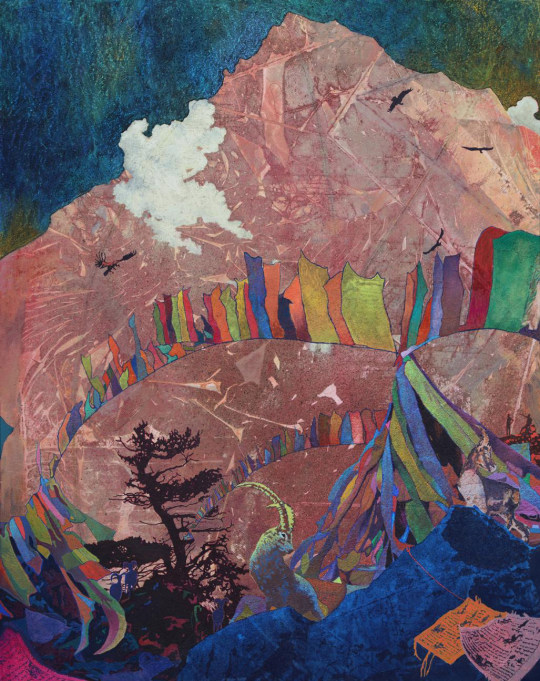
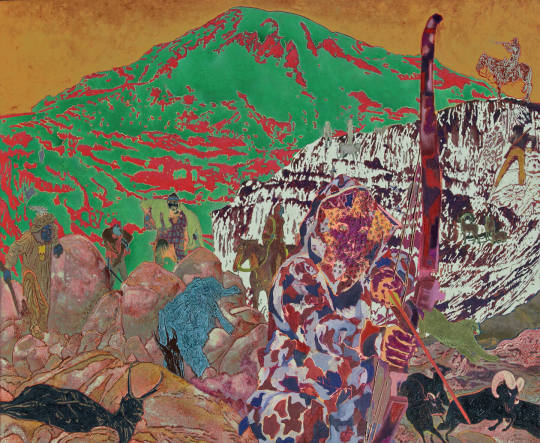
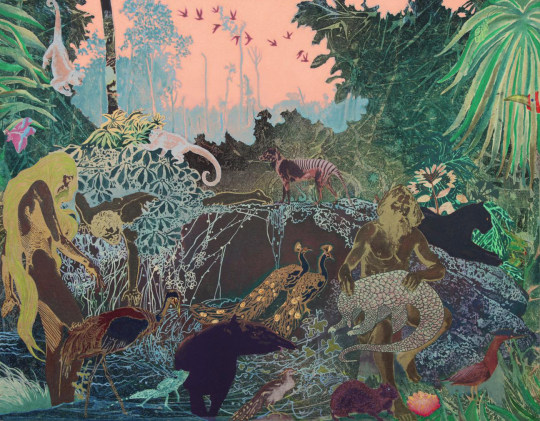

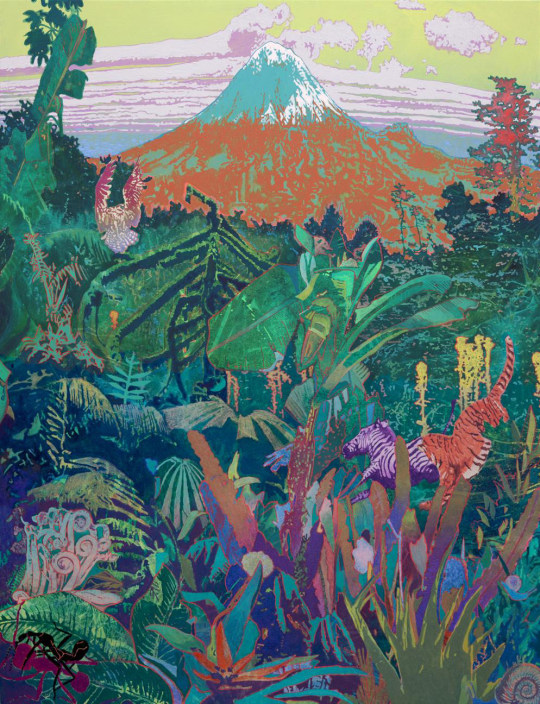

"Aaron Morse (American, b. 1974) is as influenced by the geography, history and mythology of the Southwest as he is by the language of advertising, collage, and comics. Using subjects such as American Colonial history, 19th century Romantic literature, travel and leisure propaganda, nature guides, hunting, whaling, and 20th century politics, among other phenomena, Morse’s compositions combine elements of these in colorful and complex layers. The results are akin to epic illustrations or surreal, alternate worlds where space is ambiguous and tumultuous. His large paintings and watercolors are exceptional for their technique, and recall art forms ranging from Chinese landscape painting and Japanese woodblock prints to drawings by outsider artist Henry Darger and the Beat era collages of Jess. Ecology is a major concern for the artist, whose work is based simultaneously in both reality and fantasy."
– The Santa Barbara Museum of Art
Born 1974 in Tucson, AZLives and works in Los Angeles, CA
Morse's work is included in the permanent collections of the Hammer Museum of Art, the Los Angeles County Museum of Art, The Museum of Modern Art, the Nerman Museum of Contemporary Art, the Santa Barbara Museum of Art, and the Whitney Museum of American Art, among others.
https://www.aaronmorse.com/
https://www.facebook.com/aaronmorsestudio/
https://www.aaronmorse.com/instagram/
10 notes
·
View notes